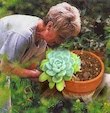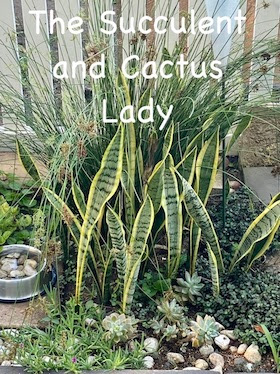About me

🌿 I've been gardening ever since a child, when I spent time with my father in his vegetable garden. But my fascination with Echeverias started in the 1980's, when my father gave me a pot with five Echeverias, which turned out to be E. imbricata. At first I wasn't much interested in them and planted them in some obscure corner of the garden and completely forgot about them. How great was my surprise when, a couple of months later, I noticed that they had spread and made a beautiful display - I was hooked!
Pages
Wednesday 31 December 2014
Happy New Year 2015!
It's been a wonderful year of planting succulents, getting pricked by cacti and seeing my little succulent family growing.
Here's wishing your new year is full of succulent love, joy and inspiration!
Happy New Year!
.
Sunday 28 December 2014
Echeveria imbricata. Flower
Echeveria imbricata is a species of flowering succulent in the Crassulaceae family, native to semi-desert habitats in Mexico. Also known as the Mexican Snowball, this frost-tender succulent rewards with lots of beautiful flowers when it gets enough sun and water.
With striking colour and texture, this fast growing Succulent is a great choice for ground-cover or a rock garden. Tight blue-grey rosettes freely produce offsets to form dense mounds. Bright pink blooms on tall stems are adored by hummingbirds and, in South Africa (we don’t have hummingbirds) Sunbirds and insects. Attractive in containers or as a house plant.
.
Wednesday 19 November 2014
Aloe cooperi
A new addition to my family - Aloe cooperi - family Aloaceae - this Aloe is a South African grassland aloe. occurs in moist habitats and in dry rocky areas, mainly in Natal, Swaziland and Mpumalanga. Aloe cooperi grows singly or in small groups from offshoots at ground level. Plants may be stemless or short stemmed up to 15cm high. The leaves are often yellowish green with the upper surface usually unspotted, though occasionally they have a few white spots lower down. The inflorescence is simple and bold. The flowers of Aloe cooperi vary in colour from greenish-cream to apricot and salmon pink. Can't wait for it to flower!
Image from
Walter Sisulu National Botanical Garden
Walter Sisulu National Botanical Garden
::
Sunday 9 November 2014
The wonder of Echeverias
It is only when we are aware of the earth
and of the earth as poetry that we truly live.
- Henry Beston, 1935, Herbs and the Earth
I’ve been absent from the world, lost in the beauty of my sunny front-yard garden. Too much work, a whole lot of plants, and life goes on. And the Echeverias (E. glauca) are flowering! A sure sign of mid-summer and lots of rain.
The Genus Echeveria is a member of the Crassulacae family and are natives of Latin America — specifically Argentina and Mexico. There are around 150 species and they are a wonderful succulent to have in your collection.
Echeveria glauca, my personal favourite, also called "Hen and Chicks", is one of the most popular. E. glauca is desirable for its blue-green colour, attractive arrangement of foliage, for their hardiness and their colourful, bell-shaped flowers on pink stems in early summer. Break them off when blooms have faded, this encourages more flowers.
They are one of the easiest succulents to grow indoors where a sunny window is a perfect spot for them. But be careful of too much direct sun through the glass as this can burn them. During summer and spring water them regularly, reducing watering in winter.
For me, growing them outdoors is a total struggle. E. glauca prefers average summer temps of 18ºC - 21ºC (65ºF - 70ºF). and in winter, cool to 10ºC (50ºF). In summer, the temperature here in Tarlton often exceeds 30ºC. And even though our winter temperatures rarely dip below 10ºC, we get a particularly bad frost that doesn't kill them but stunts their growth, making it harder for them to recover in summer. This little feature no longer exists as I had to lift them all and plant in pots.
They need a well-drained soil and our soil tends to compact quickly and become as hard as rock, even with lots of compost and sand added.
So slowly, as the years have passed, I've taken them out of the garden and put them in pots, baskets and anything else I can lay my hands on.
One can see the difference in the Echeverias that get brought in for the winter and those that stay outside.
Echeverias spread by making pups (babies), which can be harvested and re-planted but are easily propagated by taking a cutting (or by a leaf for the most of them). Besides propagation from leaves, if the main stem of the Echeveria becomes long and bare, you can cut the rosette off, let the wound dry for a week or so, and re-root the rosette. An expert recommends suspending the rosette just barely out of reach of a layer of growing mix. The rim of the pot can act as support. The rosette will send roots reaching down towards the mix. When you see a good amount of roots, it's ready to plant in the soil.
CULTIVATION TIPS
Most Echeveria are summer growers. Once established they can tolerate extended dry periods without watering but will grow stronger if they receive adequate water during their growing season. Free draining, porous soil is essential to prevent root rot. Echeveria are shallow rooted plants and therefore benefit from good levels of organic matter in the soil. Good ventilation is important for minimising pest and disease risks. Mealey bug and aphids find them irresistable so regular drenching with a suitable pesticide during the warmer months is advised - use Neem Oil which works well and is 100% organic. Generally, the more sun they get the better they will display their colours and shape, but protect them from excessive sun during hot weather.
All pics taken in my garden (Tarlton, Gauteng, South Africa).
And here are some lovely ideas I found on the internet for displaying your Echeverias and other succulents :
::
Sunday 19 October 2014
Aeonium
Aeonium are without a doubt, some of the most beautiful and sought after additions to succulent collections. They reward our efforts with gorgeous spoon shaped foliage in shades of burgundy and green, sometimes variegated with splashes of palest gold.
Aeonium are native to the Canary Islands and North Africa, so you may be able to guess their preferred conditions – warm, or even hot would be the key word.
The name means ‘evergreen’ so this is a plant that never loses its leaves – until after it blooms that is, when the flowering rosette dies.
Aeonium grow best where minimum temperatures are about 4 degrees Celsius; they can’t take any frost, so a sheltered or indoors environment only for this plant. It requires good ventilation, and bright light – full sun is fine, or partial shade. They prefer a little more moisture in the soil than many other succulent plants. Water as soon as the soil is dry, but don’t allow it to dry too much.
Some Aeonium will form a fairly tall stand of rosettes of green, dark burgundy or variegated foliage each on the top of a slender stalk. The leaves are spoon-shaped, sometimes glossy, and occasionally matte.
They can reach a height of a meter (3’), or less than 15cm (5"), depending on the variety. Other species and varieties are suitable for mixed planters and succulent crafts as they tend to be more compact.
Easy to propagate, just remove a rosette with a piece of stem and allow to callous overnight and the stem end can be planted into a pot.
Aeonium at the back with Echeveria glauca in the centre and Senecio vitalis (Blue Chalksticks) and an Echeveria in the front
Aeoniums sharing a pot with
a cactus and some Crassula
,
Sunday 28 September 2014
The outside room
As I look out to my garden
I feel a sense of pride
It really is a lovely room
Except it is outside!
~ unknown
A collection of succulents and ferns in my private bathroom-garden with a Pachypodium lamerei taking centre stage. Lots of rain, some tender loving care and the plants will smile at you. This area is fairly well protected from the cold, surrounded by high walls, but the frost does still get to the Sword Ferns. Luckily they spring back in all their glory again in spring. I've brought the Pachy and the Echeverias in the pots inside for the winter, but the basket is much too heavy to try and move. Besides which I don't have the space for it, unless I put it in the bath!
Looking from the garden into the bathroom
Looking from the bathroom into the garden
Looking from the bathroom into the garden
::
.
Wednesday 24 September 2014
Succulent dish-garden
Succulents and cacti planted
in a vintage enamelware bowl – Haworthia flanked by a Rattail Cactus and
possibly a Haworthia lassytha to the right.
I find decorating with
succulents and cacti lends a special air to any dinner setting when you have
friends over. They look wonderful as a centre piece and never fail to get the
conversation flowing!
Add a few earthy elements like river pebbles and driftwood
::
Wednesday 13 August 2014
Flowers of the Echeveria imbricata
Camera : Canon EOS 550D
Taken in my garden (Tarlton, Gauteng, South Africa)
Echeveria imbricata is one of the most popular and beautiful succulents in the Crassulaceae family, native to semi-desert habitats in Mexico. They are not as frost-hardy as some other succulents and I bring mine in every winter. They used to be spread all over my garden, but after almost losing most of them, I transplanted them into various containers and now they are thriving like never before.
::
Subscribe to:
Posts (Atom)



















































